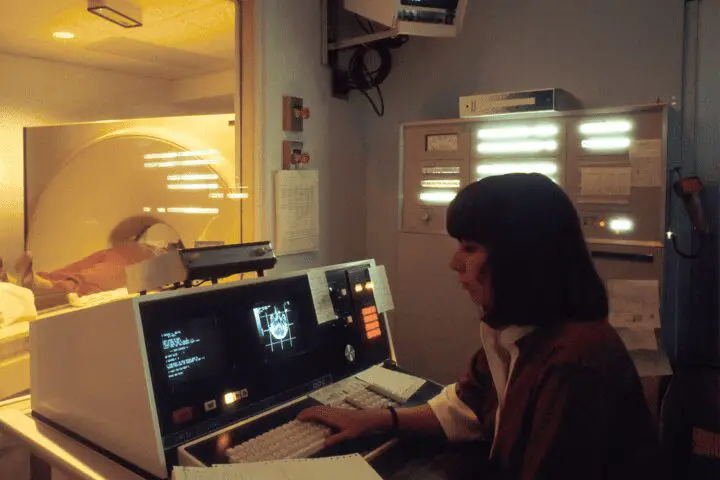Cancer is one of those very complex diseases when it comes to management and treatment. It affects the lives of millions globally, and these sudden, unpredicted changes in the disease course make it a big challenge even for oncologists. A new revolution has taken over in cancer treatment as AI begins to advance. Other developments introduced are real-time tracking of tumors-things are entirely changing in the way doctors track down and treat these tumors during radiation and other therapies.
AI provides the much-needed ingredients of precision and speed in treating cancer. It is also capable of following tumor growth with the ultimate aim of facilitating any change in treatment as early as possible. This paper will illustrate the application of AI for the real-time tracking of tumors, why it is of essence in oncology treatment, the various benefits that accrue from the use of AI in cancer patient care, and challenges arising pertaining to its implementation.
What is Real-Time Tumor Tracking?
It is the technique used by an oncologist to locate the site, size, and shape of the tumor in treating cancer.
- Dynamic Monitoring: Tumors do move in the body, most of all in such organs as lungs, liver, and kidneys, because breathing or the general movement of the body can displace them. This real-time tracking will let doctors make real-life adaptations in treatments like radiation therapy, wherein the beams hit precisely on the tumor.
- AI-driven monitoring: AI is making this tracking even more accurate. Machine learning algorithms can analyze tumor movements in real time, hence making on-the-fly adjustments in treatment. Improved targeting of cancerous cells and improved sparing of healthy tissue are the results.
- Continuous Feedback: Unlike conventional techniques that sometimes provide snapshots of the position of a tumor, AI-powered systems continuously provide feedback that helps during the treatments.


Why Real-Time Tumor Tracking in Oncology is Important?
Cancer-related treatments are usually very delicate and really call for high degrees of precision. Slight movements of the tumor itself may mean the failure of radiation therapy, or even surgery, to cover all the cancerous tissue. Here are some reasons why real-time tumor tracking is important:
1. Tumor Movement
Tumors, especially those in the lungs among others, tend to move each time the patient either breathes or changes position. This therefore presents a problem in targeting them during radiation therapy. Real-time tumor tracking allows the doctor to trace continuously the position of the tumor, and as such, treatment will be precisely aimed at the cancer cells.
2. Precision in Radiation Therapy
One of the major treatments for cancer is radiation therapy. It makes use of high energies to radiate and kill cancerous cells. However, complications may arise when the radiation misses the tumor or overexposes the surrounding healthy tissues. AI helps in tracking the exact location of the tumor and adjusts the radiation beam accordingly.
Smaller Side Effects: While focusing more precisely on the tumor, there is less risk of damage to healthy tissues, hence reducing side effects such as fatigue, skin irritation, and other serious complications. 3. Adaptive Treatment Plans
AI-powered systems have made adaptive treatments possible, wherein the oncologist might act in real time from the change in nature of the tumor-be it in shape, size, or even position. This flexibility is what patients with tumors that could either shrink or grow during the treatment will find most useful.


How AI Is Enhancing Real-Time Tumor Tracking?
AI brings a range of innovations in real-time tumor tracking, thereby enhancing accuracy and, ultimately, patient outcomes. Following are the ways in which AI contributes to this breakthrough technology:
1. Improved Imaging Technology
Conventional imaging techniques like computed tomography scans have been improved with the contribution of AI. Machine learning algorithms analyze these images in real time, and they do so much faster and more accurately than simple tumor tracking.
- Image Recognition: Tons of medical images are used for training the AI system to recognize tumors. In this way, the system can trace the tumor-maybe it has moved or changed in some other direction.
- Better Accuracy: AI is able to identify minute changes in either the structure or position of the tumor, which would in reality elude the human eye. It ascertains thereby that the treatment is focused on the site currently occupied by the tumor.
2. Machine Learning Models
Artificial Intelligence on this turf uses machine learning models that would predict how a tumor would move during treatments. These models learn from experience gained in previously treated patients how tumors generally move at different locations on the body.
- Predicting Tumor Movement: AI makes a prediction of the site to which the tumor is likely to shift. This helps the oncologist make a plan on how changes that are most probable can be accounted for during radiation therapy.
- Real-time Adjustments: While the tumor is in motion, AI models automatically make readjustments to the treatment plan in real time so that therapy hits cancerous sites effectively.
3. Integration with Robotics
Most AI-driven tumor tracking systems are integrated into the robotic technologies at the very heart of the radiation therapy machines. Guided by AI, these robotic systems can make high-precision movements to strike a tumor with incredible accuracy.
Smoother incidence of human error: AI and robotics also reduce human errors in applying treatments to cancerous tissues.
4. Data Analytics and Pattern Recognition
AI can analyze oodles of data for patterns in how tumors shrink or grow during treatment; from these, it may suggest changes in treatment plans.
AI thus allows the development of more personalized cancer treatment plans based on the particular tumor response to therapy. In such a way, patients actually get the treatments that are best for them.


Benefits of AI in Real-Time Tumor Tracking
Various benefits are attached to the use of AI in oncology, especially in real-time tumor tracking. Key advantages of the technologies include:
1. Improved Accuracy
The AI-driven systems can track tumors with much higher precision compared to traditional methods. The precision ensures that treatment for cancer, like radiation therapy, remains focused on the tumor, spares healthy tissue, and hence reduces the risk of side effects.
- More Effective Treatments: Better precision in targeting tumors means treatments are more effective at destroying cancerous cells.
- Smaller Treatment Times: It allows for shorter treatment sessions because of precision targeting and may be less burdensome for the patients.
2. Fewer Side Effects
The major balancing act in the treatment of cancer is how to treat effectively with the least damage possible to healthy tissues. AI reduces this risk by making radiation therapy even more targeted and precise.
- Safeguarding Healthy Tissue: Real-time tracking of the tumor means radiation is only directed at the tumor, reducing damage to healthy tissue surrounding it.
- Fewer complications: Precise treatment minimizes the risk of serious side effects, such as nausea, skin reactions, and damage to surrounding organs.
3. Adaptive Treatment
Among the highlighted features, it can be included that AI-powered systems enable oncologists to allow on-the-fly adjustments in the treatments as and when necessary according to the tumor response to the treatment. This ensures greater personalization for individual patients, with specific therapies also being made possible.
- Adaptation to Changes in Tumors: Tumors change shape or size during treatments. AI systems would trace the change in tumors and modify the therapy plan to fit the cancerous transformation.
- Dynamic Treatment Adjustments: AI allows dynamic changes during a treatment session to ensure most effective therapy at every stage.
4. Time Efficiency
This automates parts of the tumor tracking and treatment that could cut down on the time of a session. This improves the patient experience but also increases productivity for the treatment centers.
- Faster Sessions: With much of the data analysis and decision-making through AI, sessions can now be faster.
- Optimized Scheduling: This will further allow doctors to optimize treatment schedules in tandem with real-time data to better utilize resources and reduce patient waiting times.


AI Challenges in Real-Time Tumor Tracking
While AI is loaded with so many advantages, the challenges are also not worth mentioning that have been facing AI integration into real-time tumor tracking. The major challenges include:
1. Data Privacy and Security
Artificial Intelligence works on big data; this on the other hand makes the patient’s privacy and sensitive information related to the treatment highly vulnerable.
- Data Breach: Data breach could be one of the outputs that come into consideration when these AI systems analyze patient data lacking such securities to avoid that incident.
- Compliance with Regulatory: The concerned AI system will have to adhere to different strict regulations relating to healthcare, as for keeping patient data safely HIPAA
2. Cost and Accessibility
This tracking of tumors in real time by AI-driven systems is quite an expensive affair to put into practice. Not all healthcare might be in a position to afford all that goes into the equipment and technology in tracking tumors using AI.
- High Initial Costs: Smaller clinics or hospitals may find it rather costly to invest in integrating AI-driven systems into their oncology setup.
- Limited Access: In some regions, access to AI-driven cancer care is not available; hence, patients are also deprived of the associated benefits w.r.t advanced tumor tracking.
3. Technical Integration
There has to be thorough integration of these AI systems with the existing medical equipment and treatment technologies so that seamless functioning is ensured.
- Compatibility Issues: Not all AI systems are compatible with the radiation therapy machines or imaging devices currently available; therefore, this is a barrier to the uptake of such systems.
- Training of Healthcare Providers: Oncologists and health professionals take time training in the use of the AI-driven system, which requires financing.


Future of AI in Oncology and Real-Time Tumor Tracking
Following is some future probable role in the field in association with advancements that happens with every evolution in real-time tumor tracking:
1. AI-ENHANCED IMAGING
In this regard, AI of the future no doubt provides multiple ways of enhancements in medical imaging; it allows doctors to see tumors in previously unimaginable ways.
- Imaging Accuracy: High-resolution images than hitherto possible to bring out a tumor with much clarity; hence, better treatment of the disease due to better diagnosis of the same.
- 3D and 4D Imaging: AI may unlock 3D and 4D imaging, hence offering better and real-time visualization of tumors.
2. Integration with Genomic Data
Hopefully, in the future, AI will combine real, real-time tumor tracking with genomic data in one setup for treatments tailored to the genetics of a patient.
- Personalized Treatments: Using combined tumor tracking and genetic insight, oncologists could formulate treatments not just striking at the tumor itself but rather striking at the root of its genetic cause.
3. Global Accessibility
Real-time tumor tracking may hence be possible for patients from all over the world if AI systems become more affordable and thus ubiquitous.
AI-enabled cancer care could emerge at much cheaper prices by leveraging more mature technology, which will enable much wider dissemination among patients, especially those in underserved populations.
Integration with Telemedicine: AI can also provide real-time tumor tracking with integration into telemedicine and thus enable even remote patients to access advanced cancer treatments.
In conclusion, AI-driven approaches for the real-time tumor tracking revolutionized oncology with their precision and adaptive effective treatment against cancers. It continuously tracks tumoral displacements and provides automatic readjustment in treatments for a more adequate therapy. Though most of these are advantages provided by AI, outnumbering challenges on costs, data privacy, and technical integrations on the side of oncology,. It is expected, with further future development of the technology, that in real time the tracking of tumors will play an even bigger role in improving outcomes for cancer patients worldwide.


































There is definately a lot to find out about this subject. I like all the points you made
Thank you so much. Stay with us
This is my first time pay a quick visit at here and i am really happy to read everthing at one place
Hi! I know this is kinda off topic but I was wondering which blog platform are you using for this website? I’m getting sick and tired of WordPress because I’ve had issues with hackers and I’m looking at alternatives for another platform. I would be great if you could point me in the direction of a good platform.